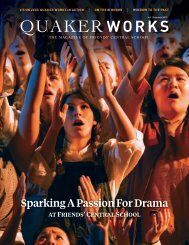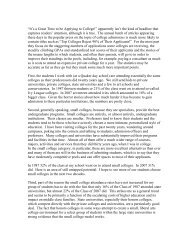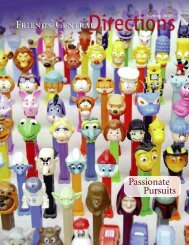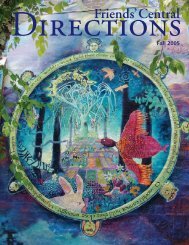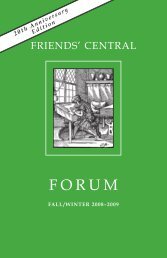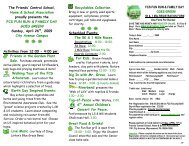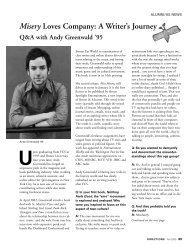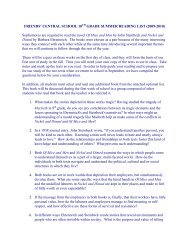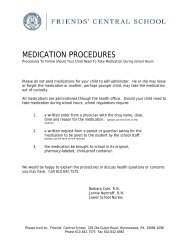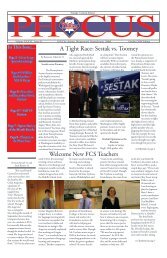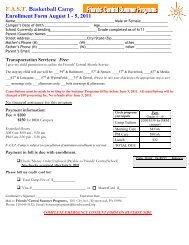2006-2007 Fall/Winter Directions - Friends' Central School
2006-2007 Fall/Winter Directions - Friends' Central School
2006-2007 Fall/Winter Directions - Friends' Central School
You also want an ePaper? Increase the reach of your titles
YUMPU automatically turns print PDFs into web optimized ePapers that Google loves.
FEATURES – CURRENT STUDENTS<br />
Teaching Each Other in Book Buddies<br />
As Friends’ <strong>Central</strong> students benefit from an abundance of good teaching, they are also encouraged to become<br />
good teachers themselves. Programs such as the Writing Lab, peer mentoring, and even many of the clubs offer<br />
students a chance to learn from and teach each other. One of the longest running of these programs is “Book<br />
Buddies.”<br />
Imagine twenty first graders in a classroom with<br />
their math books open to the page above. Hmmm, let’s<br />
see, “Measure the length of the bookcase in fathoms. Measure<br />
the length of the cubby room in paces and the length of your<br />
work table in hand spans.” Don’t forget about the cubits and digits!<br />
Now picture their two teachers trying to explain these<br />
instructions to the roomful of six and seven year olds, help the<br />
children measure, maintain some order, and verify (within reason)<br />
the 160 results produced, all within a thirty minute period.<br />
The solution? Save this math page to do with...Book Buddies.<br />
(There should be a blare of trumpets here!)<br />
Although no one seems to know for sure when Book Buddies<br />
started at Friends’ <strong>Central</strong> <strong>School</strong>, the consensus is that it began<br />
sometime in the early 1970s and may have been the brainstorm<br />
of Jane McGee, a first-grade teacher, who was seeking more<br />
opportunities for her students to read one-on-one with a good<br />
reader. As a corollary, some say the program began as an opportunity<br />
for the older children, regardless of their relative skills, to<br />
realize what competent readers they had become and provide a<br />
safe way for them to practice, demonstrate, and take pride in the<br />
skills they had acquired. All agree that the program was and is a<br />
48 DIRECTIONS <strong>Fall</strong> <strong>2006</strong> / <strong>Winter</strong> <strong>2007</strong><br />
Caroline Satalof ’11 and Melina Daniilidis ’20<br />
way to have children of different ages work on language arts and<br />
other skills in a friendly environment laced with the excitement<br />
of mingling with “unknown” people from the FCS community.<br />
Regardless of its origins, Book Buddies has thrived and metamorphosed<br />
into a tradition in which older children now regularly<br />
help to teach, and learn from, younger ones. In many ways the<br />
term is now used as a catchword for groups of students of different<br />
ages working together on projects ranging from reading, to<br />
math, to psychology, to building projects, to arts and crafts, to<br />
service. Today, the entire fifth grade serves as Book Buddies to<br />
the first grade, meeting once a week from early in the school year<br />
until <strong>Winter</strong> Break. For the rest of the year, the opportunity to<br />
be a first-grade Book Buddy is available as a service project<br />
choice to all Middle <strong>School</strong> students.<br />
Fourth graders also serve as weekly Book Buddies to kindergarten<br />
students, where last year, in one classroom, they helped to<br />
fasten the support ropes for a 15-foot replica of the Brooklyn<br />
Bridge, as well as make milk-carton cars to cross it. The annual<br />
highlight of this program, however, is probably a semiautobiographical<br />
book about the younger child written and illustrated by<br />
the older one. I still remember my daughter, who never shared



